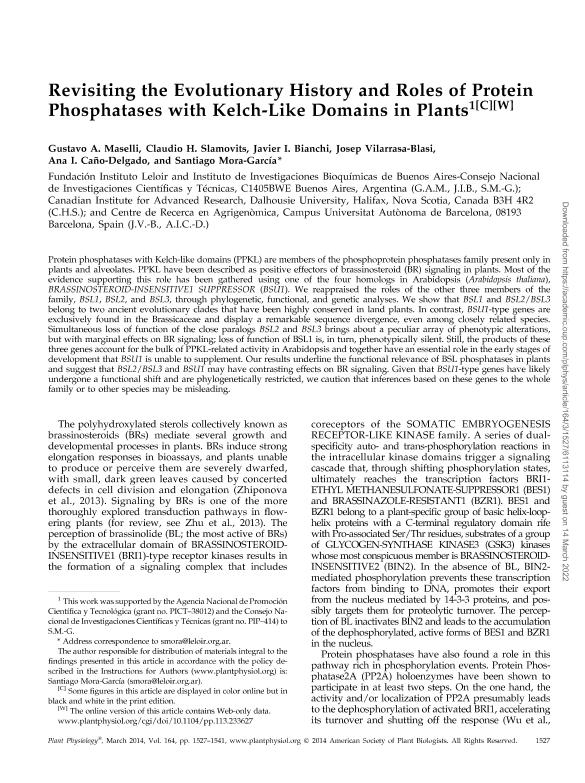Mostrar el registro sencillo del ítem
dc.contributor.author
Maselli, Gustavo Ariel

dc.contributor.author
Slamovits, Claudio H.
dc.contributor.author
Bianchi, Javier Ignacio

dc.contributor.author
Vilarrasa Blasi, Josep
dc.contributor.author
Caño Delgado, Ana I.
dc.contributor.author
Mora Garcia, Santiago

dc.date.available
2017-08-28T18:35:09Z
dc.date.issued
2014-03
dc.identifier.citation
Maselli, Gustavo Ariel; Slamovits, Claudio H.; Bianchi, Javier Ignacio; Vilarrasa Blasi, Josep; Caño Delgado, Ana I.; et al.; Revisiting the evolutionary history and roles of protein phosphatases with Kelch-like domains in plants; American Society of Plant Biologist; Plant Physiology; 164; 3; 3-2014; 1527-1541
dc.identifier.issn
0032-0889
dc.identifier.uri
http://hdl.handle.net/11336/23133
dc.description.abstract
Protein phosphatases with Kelch-like domains (PPKL) are members of the phosphoprotein phosphatases family present only in plants and alveolates. PPKL have been described as positive effectors of brassinosteroid (BR) signaling in plants. Most of the evidence supporting this role has been gathered using one of the four homologs in Arabidopsis (Arabidopsis thaliana), brassinosteroid-insensitive1 suppressor (BSU1). We reappraised the roles of the other three members of the family, BSL1, BSL2, and BSL3, through phylogenetic, functional, and genetic analyses. We show that BSL1 and BSL2/BSL3 belong to two ancient evolutionary clades that have been highly conserved in land plants. In contrast, BSU1-type genes are exclusively found in the Brassicaceae and display a remarkable sequence divergence, even among closely related species. Simultaneous loss of function of the close paralogs BSL2 and BSL3 brings about a peculiar array of phenotypic alterations, but with marginal effects on BR signaling; loss of function of BSL1 is, in turn, phenotypically silent. Still, the products of these three genes account for the bulk of PPKL-related activity in Arabidopsis and together have an essential role in the early stages of development that BSU1 is unable to supplement. Our results underline the functional relevance of BSL phosphatases in plants and suggest that BSL2/BSL3 and BSU1 may have contrasting effects on BR signaling. Given that BSU1-type genes have likely undergone a functional shift and are phylogenetically restricted, we caution that inferences based on these genes to the whole family or to other species may be misleading.
dc.format
application/pdf
dc.language.iso
eng
dc.publisher
American Society of Plant Biologist

dc.rights
info:eu-repo/semantics/openAccess
dc.rights.uri
https://creativecommons.org/licenses/by-nc-sa/2.5/ar/
dc.subject
Ppkl
dc.subject
Brassinosteroid
dc.subject
Signaling
dc.subject
Evolution
dc.subject.classification
Bioquímica y Biología Molecular

dc.subject.classification
Ciencias Biológicas

dc.subject.classification
CIENCIAS NATURALES Y EXACTAS

dc.title
Revisiting the evolutionary history and roles of protein phosphatases with Kelch-like domains in plants
dc.type
info:eu-repo/semantics/article
dc.type
info:ar-repo/semantics/artículo
dc.type
info:eu-repo/semantics/publishedVersion
dc.date.updated
2017-08-14T19:55:34Z
dc.identifier.eissn
1532-2548
dc.journal.volume
164
dc.journal.number
3
dc.journal.pagination
1527-1541
dc.journal.pais
Estados Unidos

dc.journal.ciudad
Rockville
dc.description.fil
Fil: Maselli, Gustavo Ariel. Consejo Nacional de Investigaciones Científicas y Técnicas. Oficina de Coordinación Administrativa Parque Centenario. Instituto de Investigaciones Bioquímicas de Buenos Aires. Fundación Instituto Leloir. Instituto de Investigaciones Bioquímicas de Buenos Aires; Argentina
dc.description.fil
Fil: Slamovits, Claudio H.. Dalhousie University Halifax; Canadá
dc.description.fil
Fil: Bianchi, Javier Ignacio. Consejo Nacional de Investigaciones Científicas y Técnicas. Oficina de Coordinación Administrativa Parque Centenario. Instituto de Investigaciones Bioquímicas de Buenos Aires. Fundación Instituto Leloir. Instituto de Investigaciones Bioquímicas de Buenos Aires; Argentina
dc.description.fil
Fil: Vilarrasa Blasi, Josep. Consorci CSIC-IRTA-UAB; España
dc.description.fil
Fil: Caño Delgado, Ana I.. Consorci CSIC-IRTA-UAB; España
dc.description.fil
Fil: Mora Garcia, Santiago. Consejo Nacional de Investigaciones Científicas y Técnicas. Oficina de Coordinación Administrativa Parque Centenario. Instituto de Investigaciones Bioquímicas de Buenos Aires. Fundación Instituto Leloir. Instituto de Investigaciones Bioquímicas de Buenos Aires; Argentina
dc.journal.title
Plant Physiology

dc.relation.alternativeid
info:eu-repo/semantics/altIdentifier/url/http://www.plantphysiol.org/content/164/3/1527
dc.relation.alternativeid
info:eu-repo/semantics/altIdentifier/doi/https://doi.org/10.1104/pp.113.233627
Archivos asociados
